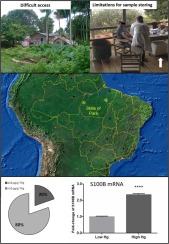NeuroToxicology ( IF 3.4 ) Pub Date : 2018-08-01 , DOI: 10.1016/j.neuro.2018.07.018 Gabriela de Paula Fonseca Arrifano , Rosa Del Carmen Rodriguez Martin-Doimeadios , María Jiménez-Moreno , Marcus Augusto-Oliveira , José Rogério Souza-Monteiro , Ricardo Paraense , Camila Rodrigues Machado , Marcelo Farina , Barbarella Macchi , José Luiz Martins do Nascimento , Maria Elena Crespo-Lopez

|
Mercury is a heavy metal responsible for human intoxication worldwide and especially in the Amazon, where both natural and anthropogenic sources are responsible for exposure in riverine populations. Methylmercury is the most toxic specie of mercury with recognized neurotoxicity due to its affinity for the central nervous system. S100B protein is a well-established biomarker of brain damage and it was recently associated with mercury-related neurotoxicity. Accurate measurement is especially challenging in isolated/remote populations due to the difficulty of adequate sample conservation, therefore here we use S100B mRNA levels in blood as a way to assay mercury neurotoxicity. We hypothesized that individuals from chronically exposed populations showing mercury levels above the limit of 10 μg/g in hair would present increased levels of S100B mRNA, likely due to early brain damage. A total of 224 riverine individuals were evaluated for anthropometric data (age, body mass index), self-reported symptoms of mercury intoxication, c-reactive protein in blood, and mercury speciation in hair. Approximately 20% of participants showed mercury levels above the limit, and prevalence for most symptoms was not different between individuals exposed to high or low mercury levels. Rigorous exclusion criteria were applied to avoid confounding factors and S100B mRNA in blood was tested by RT-qPCR. Participants with ≥10 μg/g of mercury had S100B mRNA levels over two times higher than that of individuals with lower exposure. A significant correlation was also detected between mercury content in hair and S100B mRNA levels in blood, supporting the use of the latter as a possible candidate to predict mercury-induced neurotoxicity. This is the first report of an association between S100B mRNA and mercury exposure in humans. The combination of both exposure and intoxication biomarkers could provide additional support for the screening and early identification of high-risk individuals in isolated populations and subsequent referral to specialized centers.
中文翻译:

评估偏远/偏远人群中的汞中毒:亚马逊河裸露的河岸居民血液中的S100B mRNA增加
汞是一种重金属,在世界范围内,尤其是在亚马逊河中,都是导致人类中毒的重金属,亚马逊河中天然和人为来源均是造成河流中人口接触的原因。甲基汞是汞的最具毒性的种类,由于其对中枢神经系统的亲和力,因此具有公认的神经毒性。S100B蛋白是公认的脑损伤生物标志物,最近与汞相关的神经毒性有关。由于难以保存足够的样本,因此准确的测量在孤立的/偏远的人群中尤其具有挑战性,因此在这里我们使用血液中S100B mRNA的水平作为测定汞神经毒性的方法。我们假设,慢性暴露人群的头发中汞含量超过10μg/ g限制的话,其S100B mRNA的含量会增加,可能是由于早期脑部损伤所致。总共对224名河边居民进行了人体测量数据(年龄,体重指数),自我报告的汞中毒症状,血液中的c反应蛋白和头发中的汞形态评估。大约20%的参与者显示汞含量超过限值,暴露于高或低汞含量的个体之间大多数症状的患病率没有差异。应用严格的排除标准以避免混杂因素,并通过RT-qPCR检测血液中的S100B mRNA。汞含量≥10μg/ g的参与者的S100B mRNA水平是暴露量较低的个体的两倍以上。在头发中的汞含量与血液中的S100B mRNA水平之间也发现了显着的相关性,支持使用后者作为预测汞诱导的神经毒性的可能候选者。这是关于人类中S100B mRNA与汞暴露之间相关性的首次报道。接触和中毒生物标志物的结合可以为筛查和早期识别孤立人群中的高危个体以及随后转诊至专门中心提供额外的支持。



























 京公网安备 11010802027423号
京公网安备 11010802027423号